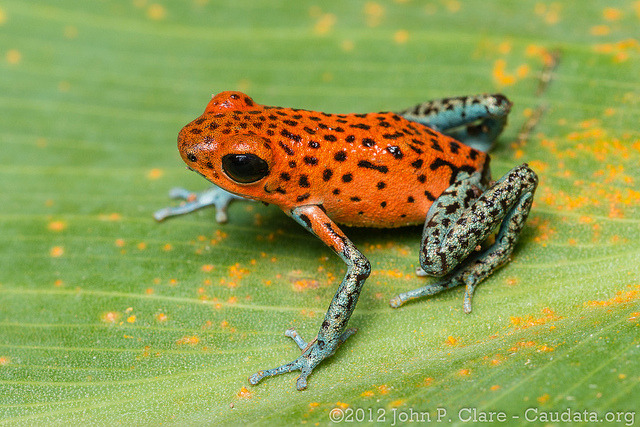越紅越凶:草莓箭毒蛙的警戒色除了警告天敵也反應個體侵略性
_(2532163201).jpg/1280px-Oophaga_pumilio_(Strawberry_poision_frog)_(2532163201).jpg) |
| 草莓箭毒蛙 (Oophaga pumilio) photo from Strawberry poison-dart frog (wiki) |
 |
| 草莓箭毒蛙較黯淡個體 photo from Terraria |
摘要
Aposematic species use conspicuous “warning” signals to communicate unprofitability to potential predators. Although warning signals are classic examples of communication systems that evolved by natural selection, they can also function in the context of sexual communication and are therefore particularly useful for investigating conspicuous trait evolution under multifarious selection. To test whether aposematic signals also serve to mediate intrasexual disputes, we observed males from a highly territorial poison frog species (Oophaga pumilio) in their native territories and in experimental dyadic contests to assess the influences of body characteristics such as warning signal brightness and body size on the outcomes of territorial interactions. We report here that although neither male size (snout–vent length) nor mass significantly predicted male aggressiveness (latency to call) in dyadic contests, a male’s dorsal brightness was a significant predictor of willingness to initiate aggressive interactions, with brighter males exhibiting a shorter latency to call than duller males. Furthermore, brightness asymmetries between males predicted the outcomes of contests such that asymmetries were smaller in escalated aggression trials (where both males called), and brighter males were more likely to be the sole aggressor in trials with large asymmetries. These tests, combined with previous work, provide evidence that warning coloration has been co-opted as an agonistic indicator trait in this aposematic amphibian and reveal the potential evolutionary lability of conspicuous traits that arise through natural selection.
一般來說,生物的警戒性(aposematism)是被認為向捕食者傳遞視覺訊號,以降低被捕食的機制。不過從一些例子來看(例如毒蝶),這些看起來非常顯眼的斑紋除了傳給捕食者外,可以傳給同種的個體,也可以是給異性的視覺訊號,刺激某種擇偶偏好,這些斑紋就顯現出不止一種功能。
草莓箭毒蛙 (Oophaga pumilio) 是一個多態型的物種,從很明亮到比較陰暗的體色都有。這種箭毒蛙的雄性有非常強的領域性,那麼這篇文章的作者就想到:這麼明亮的斑紋,會不會在雄性上代表什麼呢?比較強還是比較弱呢?佔領域上會不會有優勢呢?會不會對其他雄性比較兇呢?
 |
| 上為3D列印的模型與反射光譜,下為播放器放的蛙叫聲譜 photo from Fig. 1 |
 |
| 雄性叫聲延遲與體色、體長與體重的關係 photo from Fig. 2 |
 |
| 雄性間的「比試」是否增強與個體體色、體長、體重的不平衡度的關係 photo from Fig. 4 |
越來越多的研究證據支持警戒色/擬態物種的體色已經不如以往想得這麼簡單,也說明生物演化出一個特徵,通常不會只為了一個用途,必然受到多樣化的天擇/性擇等各方壓力,才能將這些特徵留存下來,若一有不適合,很快就可能產生變化(註:這個「很快」是萬年起跳)。





0 comments